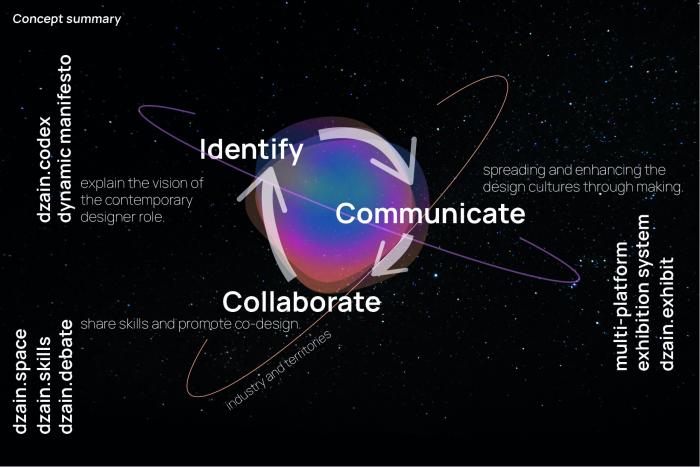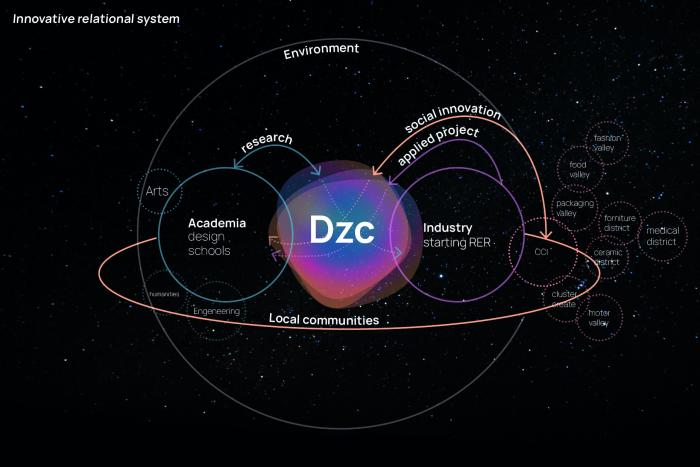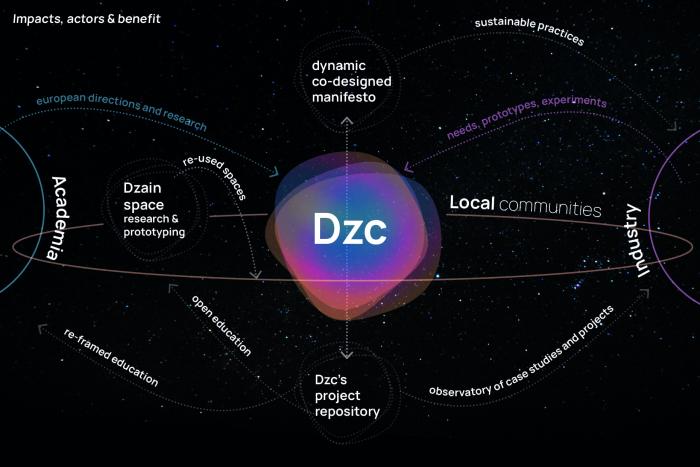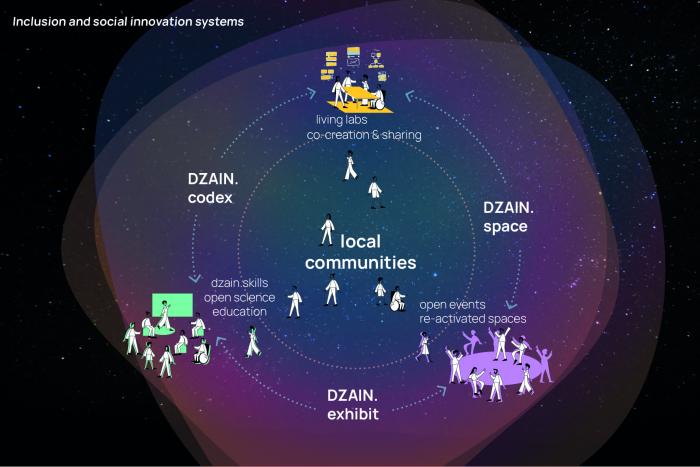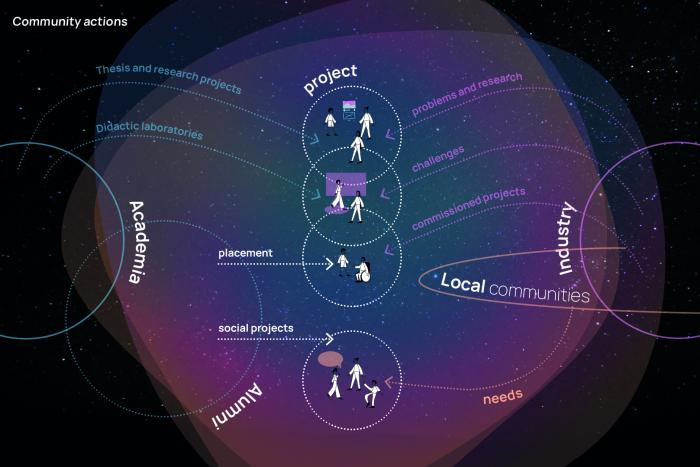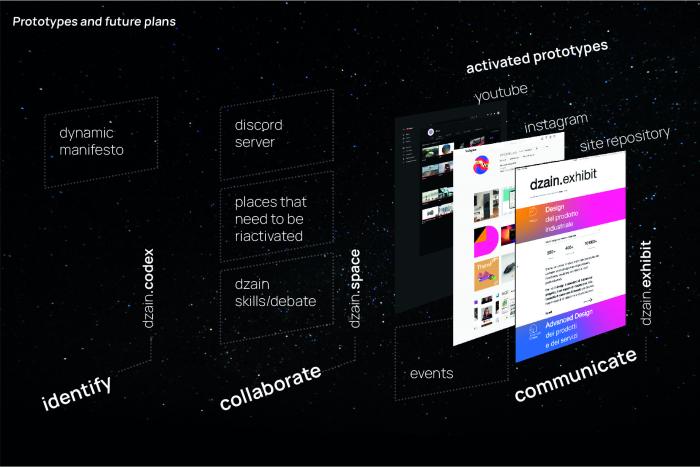I. SUMMARY INFORMATION
Project
269484
Status
Submitted
Award category
Mobilisation of culture, arts and communities
You want to submit
NEW EUROPEAN BAUHAUS RISING STARS : concepts or ideas submitted by young talents (aged 30 or less)
Project title
DZC: The DZain Community
Full concept/idea title
A system to promote tangible interaction between arts, science and technology through design culture
Description
DZC is a nebula, a cloud of stars. If the members are observed closely, they appear to be single particles in space, but if the observation is realized from a sufficient distance, the whole system becomes visible.
it's a continuous design system, open innovation-driven based on systematic co-creation approach, integrating research & innovation processes in real life communities & settings.
it's a design network sharing a codex.
it's a fluid in motion that has no form, has intentions.
Where is your concept/idea being developed or intended to be implemented in the EU?
Italy
Emilia Romagna
Via Guerrazzi 7
Bologna
40125
II. DESCRIPTION OF THE PROJECT
Please provide a summary of your concept/ idea
The DZC will be a network of students and alumni of the Design University’s Courses.
Designers create new products, processes and services with a focus on sustainability, inclusion and aesthetic. In Emilia Romagna Region, a fertile territory from the cultural, industrial and artistic point of view, designers act as a key subject: as mediators between the worlds of arts, technology and science, they connect these two realms creating value for each one, developing inspiring and visionary prototypes and projects that propose solutions on how to face global challenges.
The DZC proposes to create a space of interaction between the designers starting from University of Bologna and local actors. The aim is to promote the design cultures through a community that can mobilize the world of arts and culture through contact with industries and designers, to create a replicable format in other territories and universities.
The DZC is based on 3 pillars:
1. Identify: develop the contemporary design vision
Create a dynamic manifesto (design.codex) that outlines responsible design practices
• It ensures that products and services are designed in harmony with nature
• It is dynamic because it is the result of continuous co-design of all the community;
• It communicates to Industries what DZC can offer them
2. Collaborate: share skills and promote co-design
Create a channel to share knowledge and skills (dzain.skills) for the projects. The aim is to provide the community with a space for continuous education
Implement an inclusive work system to favour new job opportunities
Provide a physical and digital space for co-design. The DZC meets in places that need to be reactivated and it works on spaces through the actions of the designers (dzain.space)
3. Communicate: spreading and enhancing the design cultures through making
Create an exhibition system for the DZC projects. The dzain.exhibit is multi-platform, digital and physical and it is a repository of practices.
Please give information about the key objectives of your concept/idea in terms of sustainability and how these would be met
Sustainability is a connatural element of the designer’s project methodologies. The discipline of Advanced Design highlights the fundamental role of the designer in the contemporary context: it is capable of projecting its solutions into the future and it can predict their environmental, social and economic impact in the long term. In this way, designers play a key role in promoting solutions in harmony with nature by operating on the impact of man on the planet.
The key objectives of DZC in terms of sustainability are:
Create new sustainable projects both from an environmental, economic and social point of view. The DZC, placing itself between academia, industries and local players, can put into practice sustainable research born in the University and in line with European directions and it can understand the needs of industries and transmit them to University.
Create an infrastructure for prototype and testing sustainable approaches, practices and new human technologies in real conditions, in a limited and constantly evolving geographical context, with the aim of testing its feasibility and degree of usefulness for end users. Co-design prototyping is a typical method of design-driven processes and it is sustainable as it allows an iterative creative process of verification and optimization of resources before placing the product on the market.
Educate to sustainable design practices local actors involved in the production of goods and services. The DZC wants to share the processes and results of research and experimentation from an open science perspective.
Spread experts of sustainable design in the productive, social and creative territory of Emilia Romagna.
These objectives take shape through the design.codex and the design.exhibit. The first guarantees that members pursue projects aimed at environmental, economic and social sustainability. The second is a repository of sustainable projects that community members can use as guidelines
Please give information about the key objectives of your concept/idea in terms of aesthetics and quality of experience beyond functionality and how these would be met
Industrial design develops and asserts itself in the logic of industrial production, where the form is given by the equation of possibility of the material to be used, production technologies, economy of scale, representation of the company's identity and ability to read contemporary trends.
The industrial designer is able to take his own style out of the equation in favor of the sense, value and impact of the production.
From this logic, today, we are faced with an evolution that no longer concerns industrial production, but cultural production and people. The equation has become more complex and it is necessary that the cultures of the project identify new design processes that take into account the new variables.
DZC does not propose as a brand, with a static aesthetic, but aims to focus on the meaning, value and impact of the goods to be produced and finds identity precisely in this approach. The product is no longer industrial, but it is cultural, because it is the result of collective and dynamic intelligence, as it is in constant transformation. Consequently, the designer, with a global mentality, but local actions (“think globally, act locally”) becomes a translator of these motifs made up of people and relationships, through two actions:
1. brings the citizen closer to the aesthetic concept of the city through a citizen-centered design approach. The members of the DZC observe and analyze the needs, but above all they co-design with the citizens with a regenerative will with respect to abandoned places but necessary in the creation of new functions for the city.
2. designs products, services and experiences to give new value to abandoned places and then re-imagine the value production chains linked to them. (dzain.space)
The outputs and products of this approach change from place to place, by virtue of the people who come from the process, thus preserving local diversity and specificity as a rediscovered value.
Please give information about the key objectives of your concept/idea in terms of inclusion and how these would be been met
Inclusion and social innovation in work systems
The DZC aims to create a new model based on a cooperative system and more professional possibilities. It breaks down the competitive barriers of the current economic context by rewriting of internal and external collaboration. The DZC proposes a cyclical, iterative and widespread work system, through working groups formed with different levels of skills and experiences (not-extractive logic) in order to eliminate inequalities and favor a dynamic and inclusive working context with a focus on the well-being of the worker. DZC wants to work towards the elimination of the prejudices still linked with science disciplines. It promotes new forms of social relationships and of production going beyond a superficial pinkwashing strategy. Recent studies evidenced young generation increasingly challenging approach to conventional gender stereotypes: DZC assumes intersectionality as a condition to promote gender heterogeneity, including an expanding vocabulary of gender identity, a principled commitment to gender equality, gender diversity and the rights of sexual minorities. DZC ensures a balance in the different factors (age, gender, sexual orientation, race, digital skills level, specific socio-economic contexts, disabilities and abilities, living conditions, % of green per capita), in line with the Sustainable Development Goal 5 Gender Equality and MoRRI GE indicators.Intersectionality is at the core of engagement phases where designers will be involved according to social-demographic, economic and territorial variables.
Inclusion and social innovation in the territory
The DZC will focus on socially oriented projects by designing for the emerging social needs of the territory. The DZC, through culture, creativity and art, can play a role in the transformative processes on a city scale through the construction of micro-interventions in co-design with attention to disadvantaged situations and places and local minorities.
Please explain the innovative character of your concept/ idea
The innovative aspect of DZC lies in the system of both internal and external relations, aimed at facilitating a system based on the quintuple helix as an approach to the governance of social innovation. DZC places itself at the centre of an ecosystem made up of the University, Industries, public administrations, CCIs, local communities etc., as an ensemble of people able to learn and experience from and into different contexts.
The industry is able to offer the testing ground for designers who become a set of wide skills for the company and bring a shared but dynamic design vision. The process is then iterative, so, through practical experimentations with the territory, the acquired skills are reintroduced within the academy to reshape teaching and train design figures in compliance with the current framework's needs.
The plan is to create a design community with widespread skills, capable to collectively respond to the needs of the territory. Through partnerships with public administration and thanks to DZC's collective resources, it can play a role in the transformative processes at the scale of cities together with local communities.
The close relationship with the University becomes a key point for the ongoing education of the community members and for citizen science actions which include applied research actions thanks to the cooperation with several organizations. First of all with the Advanced Design Unit of UNIBO, a community of teachers, researchers and experts dealing with the project's cultures and their continuous innovation, through didactics, research and third mission, with events, relations with the territory. And with CRICC, a Research Center for the Interaction with the Cultural and Creative Industries of the UNIBO. The goal is to overcome the concept of showcase-community for student placement but to enable an ecosystem that already exists as part of a process which has had several experiments from 2015 (e.g. Bologna Design Week)
Please detail the plans you have for the further development, promotion and/or implementation of your concept/idea, with a particular attention to the initiatives to be taken before May 2022
PH0: Gain awareness: Up to now we have tried to understand, through small involvement actions, how “extensive” the community was and what the needs of the participants and stakeholders were. Only considering the students and the alumni of the University of Bologna, the community currently has about 500 students and 900 former students, 1000 companies in the databases, and countless projects and prototypes created (10.000+).
PH1: Definition of an economic model of the community: Formalize DZC with a defined economic structure, on a cooperative basis, and design the project management system and internal and external activities to "collaborate".
PH2 Definition of supporting places, physical or digital infrastructures:
(Identify) DZAIN.codex
Dynamic manifesto: Platform implementation + open source appendix
(Collaborate) Physical and digital SPACES for co-design:
Discord: Extend the server
Design Debate: design and implementation of co-design events as inclusive as possible for co-design, in workshop mode to bring the citizen closer to the aesthetic concept of the city through a citizen centered process.
Design Skills: Design and implementation of the format for peer to peer knowledge exchange events for the project, open to all, but mainly aimed at community members, as moments of exchange of experiences and knowledge.
Places that need to be reactivated: build a model to interact with the territory through small reactivations of disused physical spaces that respond to the needs identified through field, scientific and data research thanks to the network system on which the community is based.
(Communicate) DZAIN.Exhibit:
Site repository: Implementation of a repository platform of researches, experiences and case studies, in an OPEN SOURCE system (in progress)
Instagram: implementation of the Instagram page
Youtube: implementation of the Youtube channel (in progress)
PH3 Planning of dissemination events in the territory: Networking events.
III. UPLOAD PICTURES
IV. VALIDATION
By ticking this box, you declare that all the information provided in this form is factually correct, that the proposed concept/idea has not been proposed for the New European Bauhaus Rising Stars Awards more than once in the same category.
Yes
